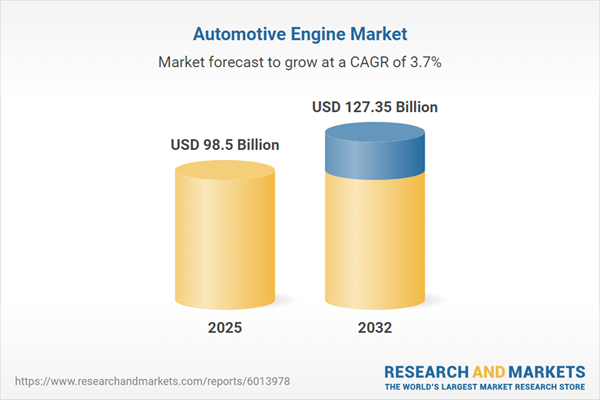Speak directly to the analyst to clarify any post sales queries you may have.
The automotive engine market is undergoing substantial transformation as industry leaders confront new regulatory, technological, and competitive pressures. Forward-thinking decision-makers need actionable intelligence to adapt product portfolios and supply chains to evolving customer expectations and disruptive innovation cycles.
Market Snapshot: Automotive Engine Market Size & Growth Outlook
The Automotive Engine Market grew from USD 94.91 billion in 2024 to USD 98.50 billion in 2025. It is expected to continue growing at a CAGR of 3.74%, reaching USD 127.35 billion by 2032. The sector’s steady expansion reflects ongoing investment in propulsion technologies, compliance initiatives, and new powertrain architectures, balancing regulatory demands with incremental and breakthrough advances. Market participants are navigating complex regional trends and shifting manufacturing strategies across varying regulatory landscapes.
Scope & Segmentation
This report delivers a comprehensive assessment of the automotive engine market, examining competitive, technological, and regulatory drivers across well-defined market segments:
- Fuel Type: CNG (with Bi-Fuel and Single Fuel systems); Diesel; Electric (encompassing Battery Electric with Lithium Ion and Solid State chemistries, Fuel Cell Electric); Gasoline; Hybrid
- Displacement Range: Large Displacement; Midsize Displacement; Small Displacement
- Cylinder Count: Eight Cylinder; Four Cylinder; Six Cylinder; Three Cylinder; Twelve Cylinder; Two Cylinder
- Vehicle Type: Heavy Commercial Vehicle; Light Commercial Vehicle; Passenger Car
- Regions: Americas (with focus on United States, Canada, Mexico, Brazil, Argentina, Chile, Colombia, Peru); Europe, Middle East & Africa (including United Kingdom, Germany, France, Russia, Italy, Spain, Netherlands, Sweden, Poland, Switzerland, United Arab Emirates, Saudi Arabia, Qatar, Turkey, Israel, South Africa, Nigeria, Egypt, Kenya); Asia-Pacific (with China, India, Japan, Australia, South Korea, Indonesia, Thailand, Malaysia, Singapore, Taiwan)
Technology adoption trends are also detailed, providing clarity on how diverse propulsion strategies, emission controls, circular economy principles, and digitalized systems are impacting vehicle design, manufacturing, and lifecycle cost.
Key Takeaways for Senior Decision-Makers
- The automotive engine market is shaped by regulatory mandates, sustainability targets, and shifting consumer sentiment, which are driving investment in electrification, hybridization, and fuel cell technology.
- Supply chain resilience is a focal point as global uncertainties prompt nearshoring, greater stockholding, and diversified sourcing models to mitigate regional risk exposure.
- Collaboration between vehicle manufacturers, tier one suppliers, and emergent tech partners has accelerated, with joint platforms and shared R&D facilities enabling the validation and scaling of new propulsion technologies.
- Segmentation by engine size, cylinder configuration, and vehicle class enables tailored product strategies, aligning with regional regulatory regimes, performance expectations, and differing fleet requirements.
- Digital tools, such as software-defined engines and predictive diagnostics, are enhancing powertrain optimization while supporting advanced manufacturing and over-the-air updates.
- Lifecycle sustainability and total cost of ownership have become primary purchase criteria, prompting OEMs to integrate circular economy practices and low-carbon production methods alongside traditional metrics.
Tariff Impact and Global Supply Chains
The implementation of revised tariff schedules in 2025 has prompted realignment across global and regional supply chains. Manufacturers are revising sourcing approaches, emphasizing local and regional production, and adopting modular platforms to adapt to cost volatility and evolving trade policy. These shifts are influential in supplier negotiation, contract structures, and long-term capacity planning, with reciprocal adjustments occurring in key export markets by trade partners.
Methodology & Data Sources
Our research applies a multi-method approach, integrating extensive secondary analysis of industry and regulatory sources with structured primary interviews across OEMs, suppliers, and market experts. Quantitative validation through scenario modeling and sensitivity analysis supports the accuracy and relevance of insights, which are further substantiated by iterative expert review. This approach ensures a robust, actionable foundation for strategic planning.
Why This Report Matters for Senior Executives
- Enable rapid response to evolving engine and propulsion technologies by aligning R&D and supply chain strategies with segment-specific and regional opportunities.
- Equip leadership teams with contextual clarity on regulatory risks, new competitive dynamics, and partnership models to guide resilient and profitable growth planning.
- Support informed investment, product development, and talent management decisions grounded in a transparent, scenario-driven assessment of the market’s future direction.
Conclusion
The automotive engine market is navigating unprecedented change driven by electrification, digitalization, and policy evolution. Leaders that prioritize flexible design, agile supply chain practices, and strategic collaboration will be optimally positioned to capture emerging growth and secure lasting competitive advantage.
Additional Product Information:
- Purchase of this report includes 1 year online access with quarterly updates.
- This report can be updated on request. Please contact our Customer Experience team using the Ask a Question widget on our website.
Table of Contents
3. Executive Summary
4. Market Overview
7. Cumulative Impact of Artificial Intelligence 2025
Companies Mentioned
The companies profiled in this Automotive Engine market report include:- Toyota Motor Corporation
- Volkswagen Aktiengesellschaft
- Hyundai Motor Company
- General Motors Company
- SAIC Motor Corporation Limited
- Stellantis N.V.
- Honda Motor Co., Ltd.
- Ford Motor Company
- Nissan Motor Co., Ltd.
- Mercedes-Benz Group AG
Table Information
| Report Attribute | Details |
|---|---|
| No. of Pages | 187 |
| Published | October 2025 |
| Forecast Period | 2025 - 2032 |
| Estimated Market Value ( USD | $ 98.5 Billion |
| Forecasted Market Value ( USD | $ 127.35 Billion |
| Compound Annual Growth Rate | 3.7% |
| Regions Covered | Global |
| No. of Companies Mentioned | 11 |









